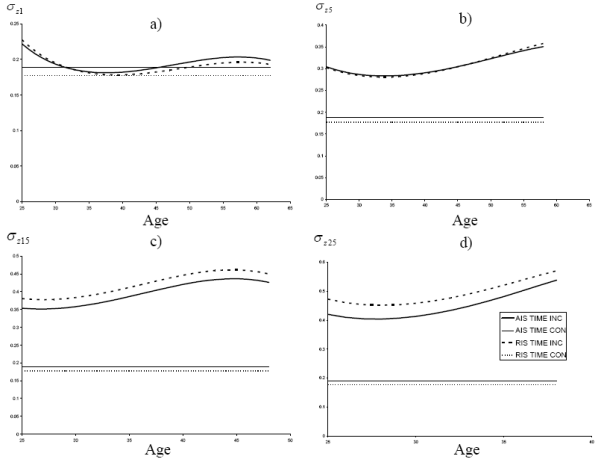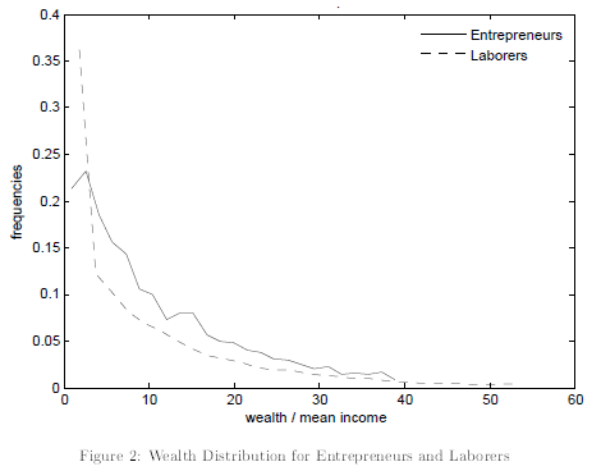FRB Finance and Economics Discussion Series Screen Reader Version Volatility Labor Heterogeneity
Post on: 16 Март, 2015 No Comment

Various studies emphasize the importance of variations in macroeconomic volatility to understand fluctuations in financial markets and the macroeconomy. 1 (Bansal, Kiku, Shaliastovich, and Yaron, 2012 ), (Bali and Zhou, 2012 ) and (Campbell, Giglio, Polk, and Turley, 2012 ) recently provided empirical evidence showing that compensation for volatility risk is important to understanding the cross-sectional variation in equity returns. In spite of the persuasive literature documenting the impact of aggregate macroeconomic volatility on asset prices, the literature has paid little attention to explaining the underlying determinants of a firm’s compensation for volatility risk. To fill this gap, in this paper I propose a production-based asset pricing model and provide empirical evidence showing that compensation for volatility risk is closely related to a firm’s reliance on skilled labor.
The production-based asset pricing model presented here extends the model of labor demand with non-convex adjustment costs of (Bentolila and Bertola, 1990 ), (Caballero, Engel, and Haltiwanger, 1997 ), and (Cooper and Willis, 2009 ) to allow for labor heterogeneity and two sources of macroeconomic risk. In my model, firms differ in their reliance on skilled labor, and they face linear adjustment costs in labor that are increasing with the skill of the worker. Also, firms face two sources of macroeconomic risk: fluctuations in aggregate productivity and time-varying volatility of productivity growth. The stochastic discount factor to compute the compensation for these risks, and asset prices in general, comes from the long-run risks model of (Bansal and Yaron, 2004 ). I use this model as a laboratory to simultaneously study the impact of fluctuations in aggregate volatility on a firm’s labor demand and its cost of equity.
In the model, a rise in aggregate volatility slows a firm’s labor demand reaction to changes in economic conditions, reducing its ability to smooth cash flows. Firms with a high share of skilled labor experience a more pronounced reduction in their ability to smooth cash flows because their labor is more costly to adjust. Therefore, investors required return for their investment increases with a firm’s reliance on skilled labor. In particular, the model suggests that the compensation for volatility risk and its contribution to risk compensation increases with a firm’s reliance on skilled labor.
To test the model implications, I first present empirical evidence supporting the model’s assumption of a positive relationship between a worker’s skill and the cost of replacing the worker. To this end, I use a unique employee-employer matched data set which contains detailed information on several costs the firm incurred filling the most recent vacant position. 2 Motivated by this evidence, I construct an empirical measure of a firm’s reliance on skilled labor as proxy for labor adjustment costs using the Bureau of Labor Statics (BLS) estimates of occupational employment along with the U.S. Department of Labor’s classification of occupations based on skill level for 1988 to 2010.
Based on panel regressions, I find that firms which have a large concentration of skilled labor have higher expected returns on equity relative to those in which a larger share of labor is unskilled. This conclusion is robust to whether I include controls for known characteristics that explain the cross-section of expected returns, such as the book-to-market equity ratio, market equity, and past performance, as well as predictors of expected returns which might be correlated with a firm’s reliance on skilled labor, such us R&D intensity, profitability, operating costs, investment rate, sensitivity of sales to macroeconomic growth, leverage, and labor intensity.
I also test if aggregate volatility has a positive impact on the risk premium implied by the reliance on skilled labor, as predicted by the model. As in (Bloom, 2009 ), I consider implied volatility computed from the old Volatility Index (VIX) and realized volatility computed using daily S&P 500 returns as proxies for aggregate volatility. I find strong empirical evidence suggesting that the risk compensation for a firm’s reliance on skilled labor increases with macroeconomic volatility. In terms of economic significance, I find that a one standard deviation increase in a firm’s reliance on skilled labor is associated with an increase in annual expected equity returns of about 2.7% in times when aggregate volatility is high. In contrast, the premium is about 1.0% when volatility is at its historical average.
On top of that, I explore the exposure to aggregate volatility of portfolios sorted on the reliance on skilled labor. First, I find that the risk premium for the reliance on skilled labor, which is the spread in equity returns between the top and bottom quintiles of portfolios sorted on the reliance on skilled labor, is high in times when the variance risk premium is high. 3 Then, I explore if the exposure to fluctuations in aggregate volatility explains the cross-section of expected returns of double-sorted portfolios on the reliance of skilled labor and market equity. The cross-sectional regression results show that the variance risk premium has a negative and statistically significant market price of risk. The single-factor model captures 40.8% of the cross-sectional variation in returns.
Finally, I explore if the risk premium for reliance on skilled labor contains information about systemic risk which is not contained in existing risk factors. To this end, I first show that the risk premium for the reliance on skilled labor is not spanned by the market excess return, the size, the book-to-market and the momentum risk factors. Then, I show that the risk premium for the reliance on skilled labor is able to explain the cross-sectional variation in average equity returns on industry portfolios. When the basic CAPM is augmented with the risk premium for a firm’s reliance on skilled labor the adjusted is 36.6%, and its market price of risk is positive and statistically different from zero. In contrast, the basic CAPM has an adjusted of 0.1%, while the Fama-French three factor model has an of only 22.1%.

The ideas in this paper build on and contribute to several strands of the literature. First, the literature exploring the implications for asset returns of time-varying aggregate volatility. (Bansal and Yaron, 2004 ) long-run risks model suggests that compensation for fluctuations in aggregate volatility carry a separate and positive risk premium. More recently, (Bansal, Kiku, Shaliastovich, and Yaron, 2012 ) present empirical evidence that all equity portfolios have positive compensation for volatility risks. Moreover, volatility risks account for one-half of risk premia in financial markets, and are important in explaining the cross-sectional variation in equity returns. Similarly, (Campbell, Giglio, Polk, and Turley, 2012 ) and (Bali and Zhou, 2012 ) also find that the exposure of equity portfolios to aggregate volatility predicts the cross-sectional variation in expected returns of characteristic-sorted portfolios. Motivated by this evidence, this paper provides an economic model and empirical evidence linking the exposure to aggregate volatility to an observed characteristic of a firm, namely, the reliance on skilled workers.
Second, the literature exploring hiring and investment decisions under uncertainty. (Abel and Eberly, 1994 ), (Dixit and Pindyck, 1994 ), (Dixit, 1997 ), and (Stokey, 2008 ) show that a firm’s factor demands are characterized by areas of inaction in the presence of non-convex adjustment costs. Uncertainty enlarges this area because the option value of the status quo increases. Recently, (Bloom, 2009 ) and (Bloom, Floetotto, Jaimovich, Saporta-Eksten, and Terry, 2012 ) explore this mechanism in an environment of stochastic volatility, and find that fluctuations in aggregate volatility can lead to bust-boom cycles. Departing from this literature, the model presented here explores the impact of time-varying macroeconomic volatility on a firm’s labor demand and its cost of capital, and how they relate to each other. Thus, the model sheds some light on the economic mechanism that links asset markets to the labor market.
Finally, the literature that empirically and theoretically explores the interaction between frictions in the labor market and asset prices. (Danthine and Donaldson, 2002 ) propose a general equilibrium model with labor-induced operating leverage. (Matsa, 2010 ), (Chen, Kacperczyk, and Ortiz-Molina, 2011 ), and (Schmalz, 2011 ) explore the impact that unionization has on capital structure decisions and the cost of equity. (Donangelo, 2011 ) considers labor mobility, and (Merz and Yashiv, 2007 ) and (Bazdrech, Belo, and Lin, 2009 ) underscore the importance of labor adjustment costs to explain the risk of equity. The model with convex adjustment costs of (Belo and Lin, 2013 ), written independently from and simultaneously with this paper, shows that labor demand responsiveness to changes in the discount rate decreases as adjustment costs increase. Using the industry level of labor skill as a proxy for the industry labor adjustment costs, they find that industries with skilled labor have a more negative expected return-hiring rate relation and higher average stock returns than industries with low-skilled labor. The unconditional spread in returns, however, is robust only for small firms. In contrast to this literature, this paper underscores the importance of non-convex costs and the real-option effect of fluctuations in macroeconomic volatility to understand the cross-sectional variation in expected equity returns. Moreover, it uncovers a novel structural explanation for differences in the exposure to macroeconomic volatility.
2 The Model
This section presents a production-based asset pricing model that builds on the models of labor demand with adjustment costs of (Bentolila and Bertola, 1990 ), (Caballero, Engel, and Haltiwanger, 1997 ), (Cooper and Willis, 2009 ) and adds two ingredients. First, I introduce labor heterogeneity. Firms differ in their reliance on skilled labor, and they face linear adjustment costs in labor which are increasing with the skill of the worker. Second, the model has two sources of macroeconomic risk: fluctuations in aggregate productivity and time-varying volatility of productivity growth. The stochastic discount factor to compute the compensation for these risks and asset prices in general comes from the the long-run risks model of (Bansal and Yaron, 2004 ). The model simulations suggest that a firm’s reliance on skilled labor is positively related to a firm’s exposure to fluctuations in aggregate volatility. Consequently, there is a an increasing monotonic relationship between expected equity returns and a firm’s reliance on skilled labor.














